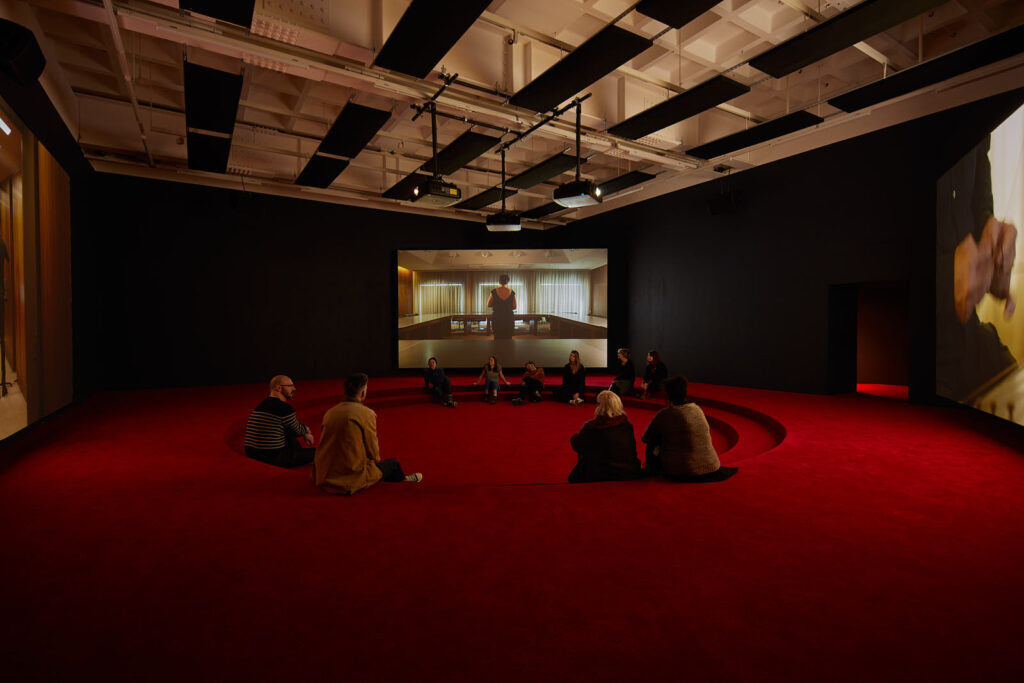Audio-visual installations have undergone a significant transformation over the years, evolving from static museum exhibits to dynamic displays in public spaces. This evolution has broadened the reach of art, making it accessible to a wider audience and enhancing public engagement. In this article, we delve into the evolution of audio-visual installations, exploring their journey from museums to public spaces and their growing impact on contemporary art and society.

The Beginnings: Audio Visual Installations in Museums
Audio-visual installations first gained prominence in museums, where they were used to enhance traditional exhibits. These installations combined sound, light, and digital technology to create immersive experiences that captivated visitors. Early examples include video art installations and interactive exhibits that allowed visitors to engage with the artwork in new and exciting ways.
In museums, audio-visual installations serve as powerful tools for storytelling, providing context and deeper meaning to the exhibits. For instance, a historical exhibit might include audio recordings of personal testimonies, bringing the past to life for visitors. This multisensory approach not only enriched the museum experience but also helped to attract a more diverse audience.
Expanding Horizons: Audio Visual Installations in Public Spaces
As technology advanced, audio-visual installations began to move beyond the confines of museums and into public spaces. This transition marked a significant shift in how art is experienced and consumed. Public spaces, such as parks, city squares, and streets, offered new opportunities for artists to engage with a broader audience.
One notable example of this shift is the proliferation of projection mapping installations. These installations use light and projection technology to transform buildings and other structures into dynamic canvases. The annual “Lumiere Festival” in Durham, UK, showcases how audio-visual installations can transform entire cities, attracting thousands of visitors and fostering a sense of community.
The Impact on Community Engagement
The evolution of audio-visual installations into public spaces has had a profound impact on community engagement. These installations create shared experiences that bring people together, fostering a sense of community and collective appreciation for art. Public audio-visual installations are often free and accessible to all, breaking down barriers that might otherwise prevent people from experiencing art.
For instance, the “Urban Light” installation by Chris Burden at the Los Angeles County Museum of Art (LACMA) has become a beloved public landmark. Comprising 202 restored street lamps, this installation invites public interaction and has become a popular gathering spot for locals and tourists alike.
Technological Advancements Driving the Evolution
The evolution of audio-visual installations has been driven by rapid advancements in technology. Innovations in digital projection, LED lighting, and interactive media have expanded the possibilities for artists, allowing them to create more complex and engaging installations. These technologies have also made it easier to install and maintain audio-visual displays in public spaces.
Virtual reality (VR) and augmented reality (AR) are among the latest technological advancements influencing audio-visual installations. VR and AR can create entirely new environments or augment existing ones, offering immersive experiences that were previously unimaginable. For example, AR installations can overlay digital information onto physical spaces, providing interactive and educational experiences for users.
Case Studies: Successful Public Audio Visual Installations
Several public audio-visual installations have garnered widespread acclaim for their creativity and impact. One such example is the “Waterlicht” installation by Dutch artist Daan Roosegaarde. This installation uses light and sound to simulate a virtual flood, raising awareness about rising sea levels and climate change. Displayed in various public spaces around the world, “Waterlicht” has successfully engaged communities and sparked important conversations about environmental issues.
Another example is the “Pulse” series by Mexican-Canadian artist Rafael Lozano-Hemmer. These installations use biometric data from participants, such as heart rates and fingerprints, to create interactive light and sound displays. Displayed in prominent public locations, “Pulse” installations have encouraged public participation and highlighted the interconnectedness of individuals within a community. Read More: Exploring the Impact of Audio Visual Installations in Modern Art Galleries
The Future of Audio Visual Installations
The future of audio-visual installations looks promising, with continued technological advancements paving the way for even more innovative and engaging displays. As artists continue to explore the possibilities of VR, AR, and other emerging technologies, audio-visual installations are likely to become even more immersive and interactive.
Public spaces will continue to serve as important venues for these installations, providing opportunities for community engagement and collective art experiences. The increasing accessibility of technology will also enable more artists to experiment with audio-visual installations, further democratizing the art form.
Conclusion: Embracing the Digital Art Revolution
In conclusion, the evolution of audio-visual installations from museums to public spaces represents a significant shift in the art world. These installations have transformed the way art is experienced, making it more accessible and engaging for a wider audience. As technology continues to advance, the potential for audio-visual installations to enrich our public spaces and communities is limitless.